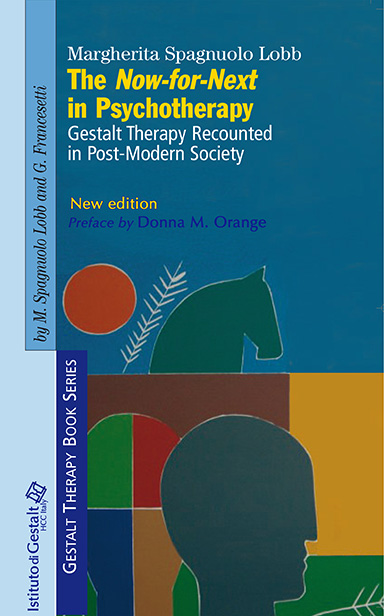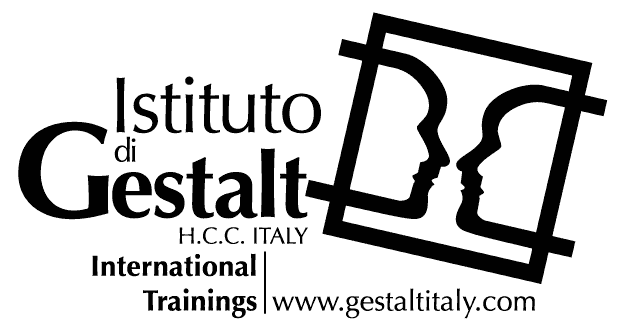
The Now-for-Next in Psychotherapy
Gestalt Therapy Recounted in Post-Modern Society
by Margherita Spagnuolo Lobb
Preface by Donna Orange
ISBN: 978-88-989-1203-2
Back Cover
Gestalt therapy sees the therapeutic relationship as the occurring, the coming to light of a co-creation between patient and therapist. By means of clinical cases, the author leads the reader on her path of understanding of the Gestalt approach, which is focused on the desire for contact that animates relational unease and on the process that reveals its “music”.
In these ten chapters, the author offers her readers a professional and human maturity developed over the thirty years of passion she has brought to her tireless work for Gestalt therapy in Italy and abroad.
This book greatly adds to Gestalt therapy’s intellectual and spiritual resources (…). I call this attitude clinical humility, an essential condition for the possibility of analytic love or affection that will not collapse, become destructive, or self-destruct. This book embraces with clarity and courage the need for the patient actually to matter emotionally to the therapist. Read on!
(From the Preface by Donna Orange)
But the merits of this book are not limited to showing the interconnections a- mong schools, or to updating Gestalt therapy to contemporary society, studying the technique in depth in various clinical contexts. For me this book has yet a- nother merit: it leads the reader on an adventure that is not only intellectual but also engrossing from the emotional point of view. And this is a central characte- ristic of Gestalt therapy that has always fascinated me.
(From the Preface by Paolo Migone)
Buy now
Discounted Book price: 35 Euro
Book Reviews
Contents
Preface, by Donna Orange
Preface to the Italian Edition, by Paolo Migone
Acknowledgements
Introduction
1. The Reasons for the Book; 2. Gestalt Creativity: a Resource and a Limit; 3. Development of Social Feeling and Psychotherapy; 4. Intentionality and Contact Boundary: Gestalt Therapy in Post-Modern Society; 5. Psychopathology as Creative Adjustment; 6. The Chapters of the Book; 7. To Conclude…
Chapter 1. Gestalt Clinical Practice in Post-Modern Society
1. From the Intrapsychic Paradigm to the Paradigm of the Co-Created Betweenness; 2. The Therapeutic Relationship as a Real “Fact”: the Sovereignty of the Experience; 3. The Role of Aggression in the Social Context and the Concept of Psychopathology as Unsupported Ad-gredere; 4. The Unitary Nature of the Organism/Environment Field, Tension to Contact and the Formation of the Contact Boundary; 5. A Psychotherapy Based on Aesthetic Values; 6. The Figure/Ground Dynamic; 7. Post-Modern Clinical Practice in Action; 8. What Changes According to Gestalt Clinical Practice?
Chapter 2. The Self that Creates and is Created in the Contact. Classical Theory of Gestalt Therapy
with interventions by Philip Lichtenberg
1. First Path: “Meeting” the Founding Book ‒ A Question of Methodology; 2. Second Path: the Novelties Introduced by the Founders ‒ Their Questions; 3. Third Path: the Theoretical Lines; 4. Fourth Path: Recent Theoretical Developments; 5. Conclusion
Chapter 3. The Depth of the Surface. Somatic Experience and Developmental Perspective in Clinical Evidence
1. The Gestalt Therapist’s Attention to Bodily Experience; 2. The Question of the Developmental Theory of Gestalt Therapy; 3. Diachronic and Synchronic Levels: Figure and Ground of Contact Making; 4. The Gestalt Therapy Map of Polyphonic Development of Domains; 5. Gestalt Therapy’s Developmental Perspective as Clinical Evidence; 6. Clinical Examples; 7. Conclusion
Chapter 4. Recounting Oneself in Therapy: the Now-for-Next and Gestalt Diagnosis
1. Co-Created Narration at the Contact Boundary; 2. Grasping the Now-for-Next in the Patient’s Story: Diagnosis and Therapy in Action; 3. Conclusion
Chapter 5. Aggression and Conflict in Post-Modern Society and in Psychotherapy
1. Aggression and Conflict: Anthropologies Compared; 2. Aggression, Conflict and Intentionality of Contact in Post-Modern Society; 3. Working Through Conflict in the Therapeutic Contact: a Clinical Example; 4. From the Need for Aggression to the Need for Rootedness: a New Clinical and Social Perspective on Conflict; 5. Conflict in the Therapeutic Relationship Today: from the Support of the Figure to the Support of the Background; 6. Clinical Examples on Supporting the Ground in the Case of Experience of Aggression; 7. Conclusion
Chapter 6. Love in Psychotherapy. From the Death of Oedipus to the Emergence of the Situational Field
1. Introduction; 2. The Therapist’s Love; 3. The Patient’s Love; 4. Love in Therapy as an Emergent Event at the Contact Boundary; 5. The Oedipus Complex and the Relational Knowledge Implicit in the Psychotherapeutic Setting: an Overcoming of the Id/Ego Polarity; 6. Intentionality for Contact: the Now-for-Next in Psychotherapy; 7. Sexuality and Love in a Situational Field; 8. From the Myth of Oedipus to the Triadic Situational Field; 9. Two Clinical Examples of the Triadic Perspective in a Dyadic Therapeutic Setting; 10. Conclusion
Chapter 7. The Now-for-Next in Couple Psychotherapy
1. The Life of the Couple as Excitement and Growth at the Contact Boundary: the Gestalt Therapy Proposal; 2. Three Experiential Dimensions of the “Normality” of the Couple; 3. A Model of Gestalt Therapy with Couples; 4. Appeal for Help and Social Values; 5. Clinical Example: “The Dance of the Narcissists”; 6. Conclusion
Chapter 8. The Now-for-Next in Family Psychotherapy
1. The Family as Environment and as Organism, or the Plea for Help as Creative Act; 2. The New Paradigm of Treatment of Family Relationships; 3. Gestalt Therapy with Families; 4. An Example of Post-Modern Daily Life; 5. Gestalt Criteria for Diagnosis and Intervention with Families; 6. A Model of Gestalt Family Intervention; 7. The Model in Action: A Family Session; 8. Final Comment
Chapter 9. The Now-for-Next in Group Psychotherapy. The Magic of Being Together
1. Gestalt Intervention with Groups; 2. Perls’ Work in Groups; 3. The Cultural Evolution of Being-in-Group and the Gestalt Literature; 4. A Model of the Gestalt Intervention in Groups; 5. The Application of the Gestalt Group Model; 6. Conclusions
Chapter 10. Training in Gestalt Therapy. Novelty, Excitement and Growth in the Group
1. The Ethics of Gestalt Training; 2. The Teaching/Learning Community: Teaching to Give Form in Liquidity; 3. The Developing of the Self-in-Formation; 4. Belonging Independence: the Permission to Create Wellbeing in Society
References
The Author

Margherita Spagnuolo Lobb was born in 1956; she lives in Syracuse (Italy), and travels extensively to teach in Italy and abroad. She is a psychologist, a licensed psychotherapist, the founder and, since 1979, director of the Istituto di Gestalt HCC, approved by the Italian Minister for Universities, with premises in Syracuse, Palermo and Milan. She is a Full Member of the New York Institute for Gestalt Therapy, past-president of the Italian Federation of the Associations of Psychotherapy (FIAP), past-president and first Honorary Member of the European Association for Gestalt Therapy (EAGT), past- and Honorary President of the Italian Association of Gestalt Psychotherapy (SIPG). Since 1985, she has edited the Italian journal Quaderni di Gestalt and has served on the board of several other international journals. She has written many articles, chapters and books published in various languages. The present volume has been published in English, Italian, Spanish, Russian and Rumenian. She has fostered the dialogue between Gestalt therapy and the most important contemporary psychotherapists and researchers, such as Daniel Stern, Vittorio Gallese, Elisabeth Fivaz-Depeursinge, Donna Orange, Umberto Galimberti, and others.
How to quote this book
ISBN: 978-88-989-1203-2

